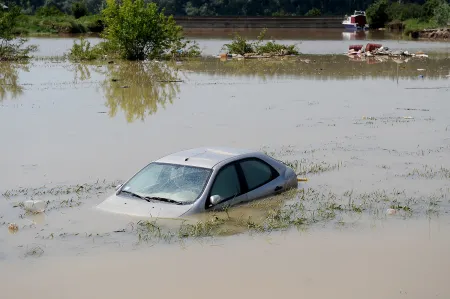As I write this from the SESYNC offices, in Annapolis, MD, the Eastern Seaboard is recovering from a chimeric “Frankenstorm,” caused when two storm fronts converged in the mid Atlantic Ocean. The energy they held as they clashed could surely power coastal cities for weeks. Instead, it did the opposite, brutally fraying the order—the carefully insulated buildings, the subways and rail networks, the power grids—we work so hard to build, maintain, and replicate. The weather services predicted it could be a once-in-a-century storm.
The consideration of these separate forces is a good metaphor for the historic consideration of society and environment, and the titanic clash highlights the scale of today’s environmental problems. The storm began out at sea—out of sight, out of mind, just meteorological. Socio-environmental problems in a globalized world, a perfect storm, constitute both an obvious problem and a genuine opportunity to enhance understanding and take enlightened action. The promise of SESYNC is in embracing that challenge.
A recent SESYNC workshop on Linking Socio-Environmental Science to Socio-Environmental Change, hosted at partner organization Resources for the Future (RFF), explored the sticky problem of coherently moving scientific knowledge through the often disconnected networks of people and organizations managing human-environmental systems. Presentations and discussions illuminated how the actors involved, from businesses to agencies, often form insulated clusters, and that decisions are often made by a single powerful actor, such as a planning board, without input from other clusters and with strikingly little direct experience with the environments being affected. During breakout sessions, attendees discussed the difficulties of productively crossing the boundaries between experts “holding” knowledge and decision makers acting on it. They also discussed the importance of “reflexiveness”— remembering that working models about translating knowledge into action can affect resulting decisions as much as the science itself. Participants from resource-management agencies, universities, and nonprofits advocated using a range of social-change theories to guide this translation. Such pluralism is a necessary part of the evolution of science, during which ideas and approaches compete and cooperate, cross-fertilize, and coalesce.
Yet, if “the whole of science is … a refinement of everyday thinking,” ” as Einstein suggested, then we must both offer and assess ideas about the structure, functioning, and sustainability of socio-environmental systems, winnowing options to those that work best. Comparing systems and outcomes will be important. Distilling the findings into a core body of understanding will be crucial. Socio-environmental science, sustainability science, coupled human and natural system science—different names for synonymous studies—have amassed a great deal of data and knowledge, sometimes siloed in individual disciplines or theories but often interdisciplinary, and usually case-specific but sometimes comparative. Nevertheless, our understanding of socio-environmental systems, particularly the hyper-powered ones of today and tomorrow, is still nascent. We may know the principles from physics, chemistry, and geology behind weather and the principles from biology, sociology, psychology, economics, and anthropology behind human behavior, but only synthesizing this knowledge and searching for deep patterns will provide wisdom about the broader storm system and the most intelligent actions we can take to change the things we can change and to accept and adapt to those we cannot.
